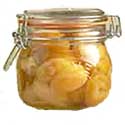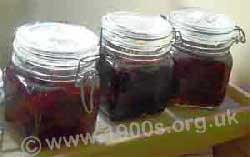How to preserve fruit: bottling, jam-making, pickling and wrapping

When fruit ripens in season and there is a glut, it needs to be preserved for use during the rest of the year, preferably without taking too much room in the freezer. In the past, when there were no freezers anyway, people managed very well using methods that work just as well today. This page describes them. It includes ways of preserving fruit such as plums, apples and tomatoes as well as using the fruit for jams and chutneys.
____
By the webmaster, based on watching and talking to older people
Why preserving home-produce was essential in the past
Preserving home-produce was always important in the past for reasons of cost and availability. It was even more important during the Second World War when it was essential to let nothing go to waste if the population was to stretch its meagre rations and have little extra treats throughout the year. This was because Hitler tried to starve Britain into submission. So imported food was in short supply because of the risk to merchant seamen of bringing it in from overseas. These seamen risked their lives bringing in what they did, in perpetual fear of being sunk by German submarines. Consequently householders made a point of preserving what food they had.
Remember there were no fridges or freezers in the households of ordinary people until the 1950s and 1960s.
Bottling fruit in Kilner Jars
Fruit was preserved by 'bottling'.
Bottling required special glass jars known as Kilner Jars which had tightly fitting spring lids to stop leakage and to keep out air. The seal was made even more secure with special rubber rings. These rings had to be replaced every season, but the jars went on year after year.

Fruit preserved by bottling in Kilner Jars - photographed at Lincolnsfields Childrens Centre, Bushey
To preserve the fruit, it was cooked to kill any bacteria, and while still hot was poured to overflowing into the Kilner jars which had been slowly heated in the oven, also to kill any bacteria but also to prevent them breaking with the sudden heat of the cooked fruit. Then the jars were sealed, and when cold, washed to remove any overflowing juice.
Bottling worked well, although occasionally some mould did get in to spoil the fruit. This was likely to happen if the fruit was not completely cooked through and if any air was left in the jar before it was closed.
We had a small garden when I was a child, so we didn't have enough fruit to bottle. However I clearly remember trying the results of other people's bottling which I didn't like very much, as it seemed to have too uniform a consistency. Nevertheless, the point was that it worked.
The bottled fruit was used in pies and as it was with custard poured over. There was no cream on sale in WW2, but before then it was readily available.
According to an African friend, sun-drying was a common method of preserving because it removes the moisture from fruits which stops the growth of bacteria. Apples, for example, are sliced and dried to create apple chips or rings - but I never saw this done. Britain does not have enough sun to make it feasible.
Making jam and chutney
Although my mother never had enough garden fruit to make jam or chutney, it was common among households with larger gardens. I don't remember trying the results in the war, probably because they were not given away freely to anyone outside the family.
However, I have tried making both in my early adult life. The problems with jam-making are how difficult it is without specialist equipment to get a set which is not too solid or too liquid and how easily mould seems to get into the jars. During wartime there was the added problem of sugar being rationed. Women saved their sugar for jam making, but just imagine the disappointment if months of sugar ration was wasted if the jam didn't work properly!
The problem with my chutney making was that the family preferred the bought jars. In the shortages of the war, of course, they would have had to put up with it or go without, but the war was long-gone when I had my children.
Storing apples and tomatoes in brown paper
The only fruit we had in any abundance in our small garden were apples, and occasionally tomatoes in a good year.
To keep tomatoes, they had to be stored out of the light and at the right humidity. My mother said that she kept tomatoes, wrapped in brown paper in a drawer until Christmas, but I wasn't fond of them as a child, so can't remember them.
The accepted wisdom seemed to be that apples should be wrapped in special waxed paper, but I don't think that my mother ever did this. Our apples were kept on layers of brown paper on trays or in cardboard boxes. The paper was important to absorb the juices of any apples going bad, and trays were better than boxes because apples beginning to rot could be spotted more easily and removed. One rotting apple always caused those touching it to rot as well. We managed to keep apples until March.
| sources | webmaster | contact |
Text and images are copyright
If you can add anything to this page or provide a photo, please contact me.



